Water reuse – is a big opportunity just going to waste?
The UN Food and Agriculture Organization (FAO) cites water scarcity as one of the leading challenges for the sustainable development[1] of our society. While desalination has traditionally been seen as the crucial solution for addressing this, recent developments in the wastewater treatment industry look set to transform the contribution of wastewater reuse to meeting our water needs.
Global consulting firm, McKinsey & Company, says water is as important to the World’s economy as oil or data[2]. This may sound strange considering that water is the most abundant resource on the planet. But unfortunately, only 1% of it is fit for human consumption. 97% is seawater and a further 2% comprises ice or snow around the poles[3].
This situation is compounded by the fact that our demand for water is far outpacing supply. By 2050, demand for the water we consume for agriculture, industry and domestic use is expected to grow by more than 50% to feed an estimated 10 billion world population[4].
Already, almost 25% of the world’s 410 water basins (the lowest points to which water drains from the higher areas) are ‘highly stressed’, with annual withdrawals exceeding supply by 40%. Around half of these are within three countries with huge water demand – the US, India and China. Estimates suggest that by 2030, global water basin supply could decrease by 10%, and 25% by 2050[5].
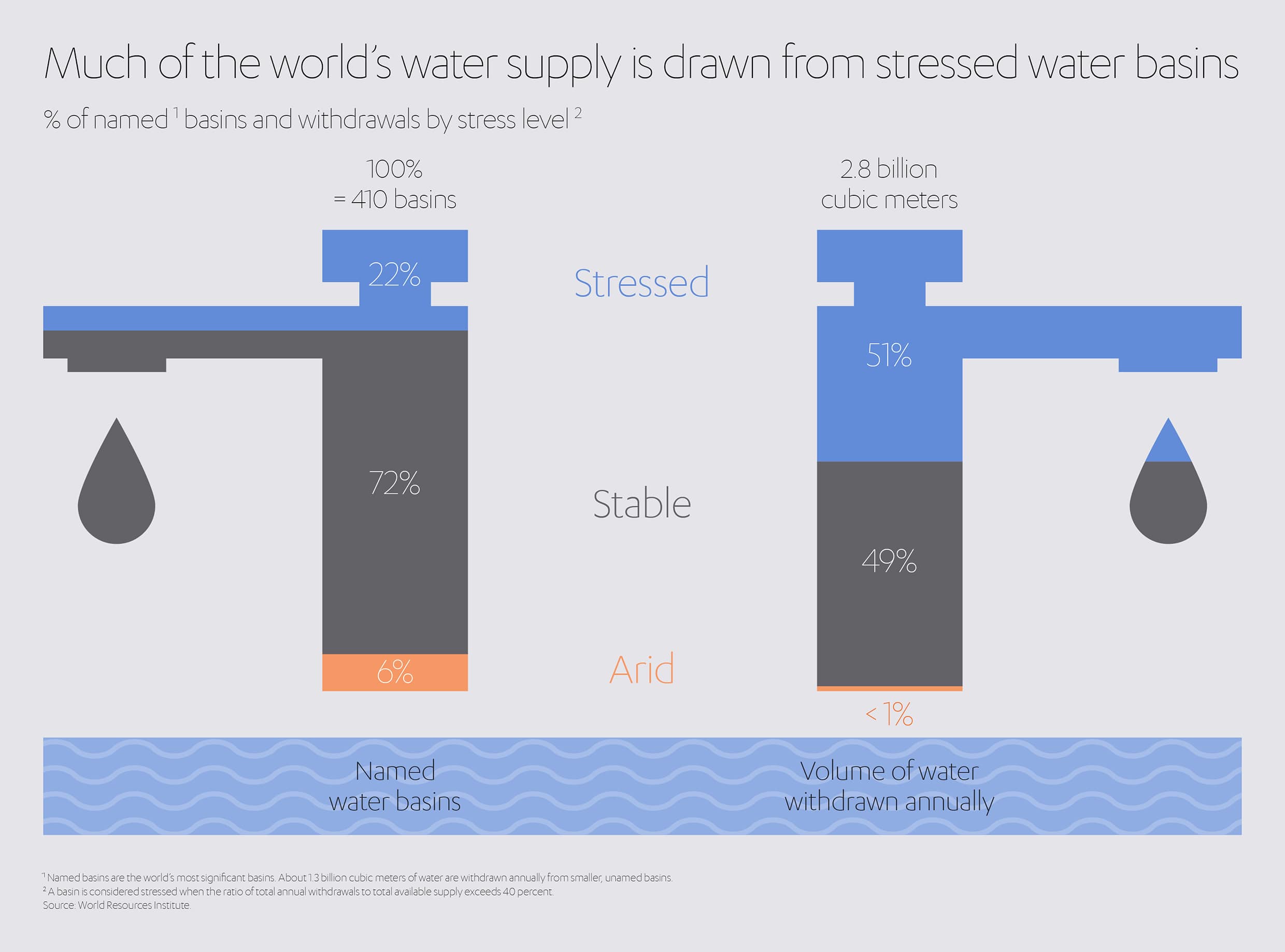
This 2030 position is echoed by the latest World Water Development Report from UNESCO’s World Water Assessment Programme[6] (WWAP) – nearly 50% of the global population will suffer water stress, and by the same year demand will outpace supply by 40% if we don’t change our current levels of consumption. In sub-Saharan Africa alone, demand will increase by 283% in 2030 compared to 2005[7], with water becoming scarce even in areas where it is currently abundant.
“Water risk is not a worry to be addressed in some nebulous future,” said McKinsey & Co. in its report, ‘Water: A human and business priority’. “The supply of fresh water has been steadily decreasing while demand has been steadily rising. In the 20th century, the world’s population quadrupled—but water use increased six-fold.”
There is also an economic cost. The societal impact and consequences of water scarcity are likely to be severe. By 2050, World Bank experts believe that water scarcity, exacerbated by climate change, could cost some regions up to 6% of their gross domestic product, while spurring migration and sparking conflict[8]. In contrast, the negative impacts of climate change on water could be neutralized with better policy decisions, with some regions standing to improve their growth rates by up to 6% with better water resource management (see diagram below).
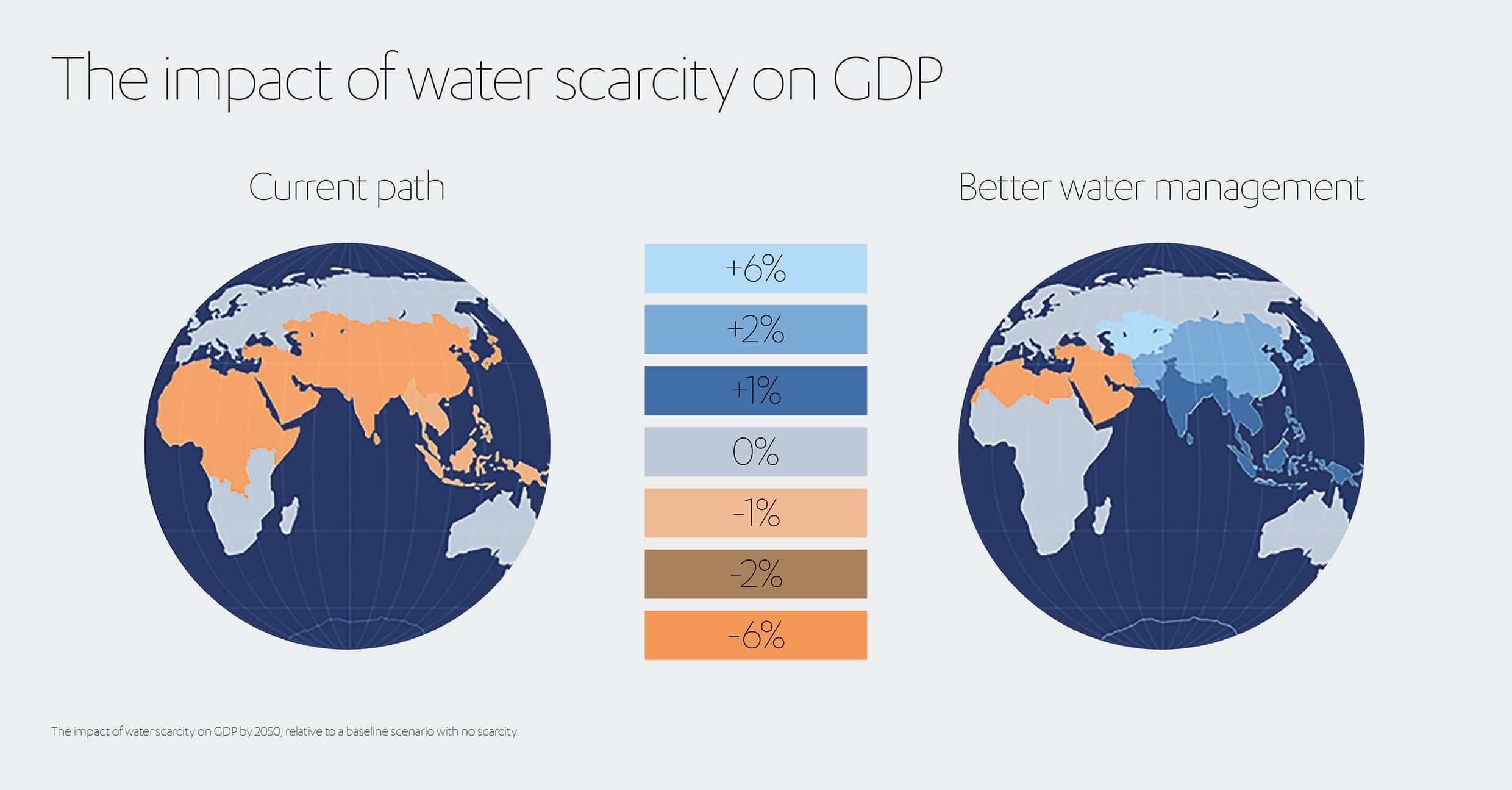
“Regardless of the magnitude of future global, and more importantly local, water deficits, water scarcity is likely to limit opportunities for economic growth and the creation of decent jobs in the coming decades,” warns the WWAP in its water development report.
The domino effect
The issue of water scarcity is not an isolated risk – it is inextricably linked to a whole host of other challenges facing our planet. Among the main aims of the 17 United Nations (UN) Sustainable Development Goals (SDGs) are Clean Water and Sanitation (SDG 6), Climate Action (SDG 13), Affordable and Clean Energy (SDG 7), and Zero Hunger (SDG 2), with each having a considerable effect on the others.
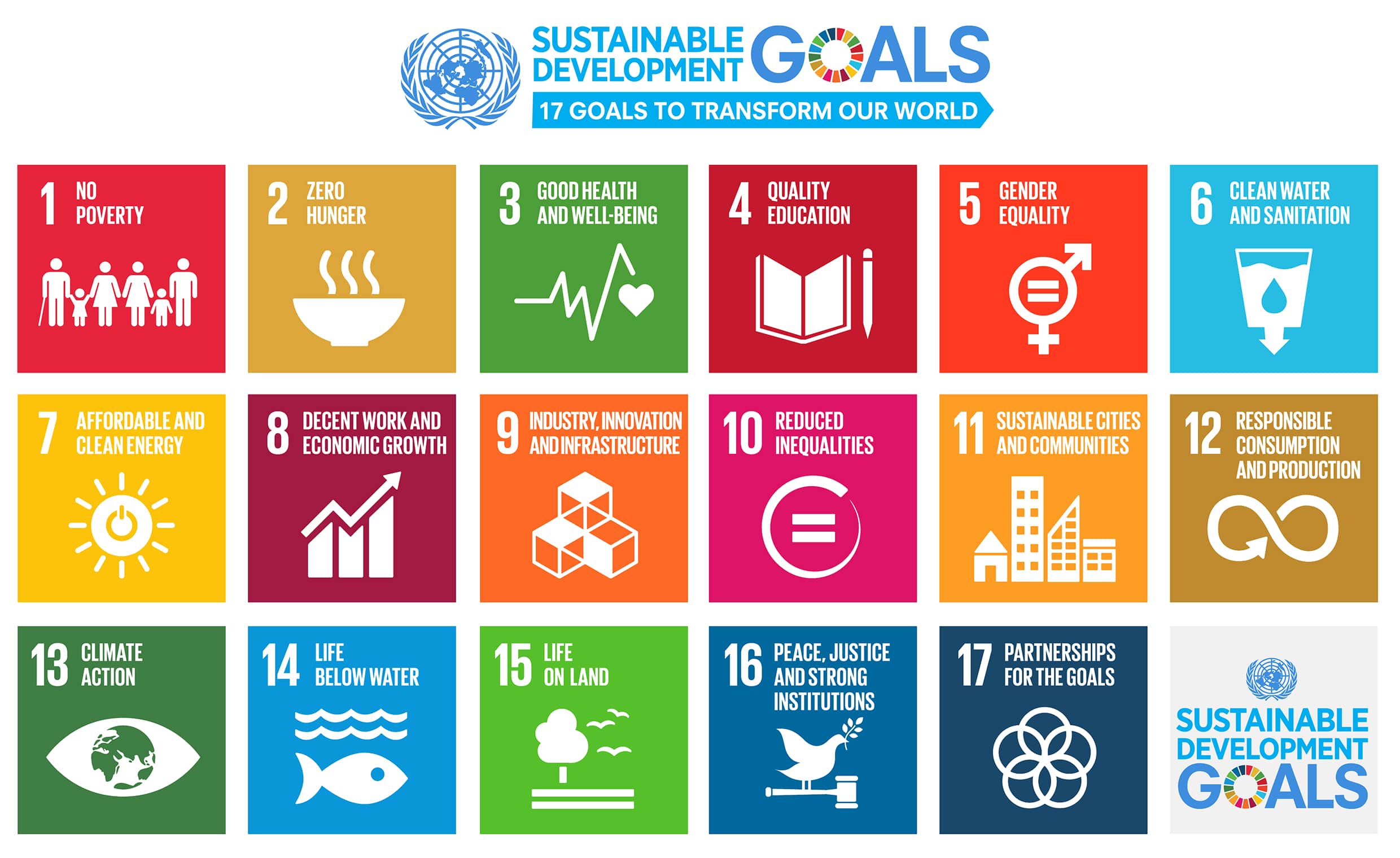
In its Global Risks Report 2020, World Economic Forum cites water crises as the fifth top risk by severity of impact. Fourth is extreme weather events such as storms, and first is climate change[9].
The devastating effect of climate change (SDG 13) on our water supplies can no longer be in any doubt, with droughts, water shortages and natural disasters caused by unpredictable rainfall and floods. The FAO estimates that, “For each one degree of global warming, 7% of the global population will see a decrease of 20% or more in renewable water resources”[10].
Nor can the link between clean water and health (SDG 3) be over-stated. Globally, it is estimated that up to 60% of illnesses are water-related[11]. The WWAP’s Water Development Report is even clearer in its conclusions. It states that:
“Realizing the human right to safe and sufficient water and adequate sanitation will enhance the health and quality of life of millions of people, not only the poorest.”[12]
Inadequate water and sanitation have been conservatively estimated to cause nearly two million preventable deaths each year, with the greatest burden falling on children under five years old.
In addition, better management of water resources to reduce the transmission of vector-borne diseases and to ensure that lakes and rivers used for recreation do not contain harmful levels of fecal pollution or algal blooms, can save many lives and has extensive direct and indirect economic benefits. Many foodborne illnesses are also related to poor quality of water used in food production, post-harvest processing or food preparation. Recent estimates suggest that the total area of agricultural land close to urban centers irrigated by mostly untreated urban wastewater has reached about 36 million hectares – equivalent to the size of Germany[13].
Desalination – the traditional solution
The main solution for addressing this problem by creating new water supplies has traditionally been desalination: extracting the salt from seawater and making it suitable for human consumption. Globally, more than 300 million people now get their water from desalination plants, according to the International Desalination Association.
By using different technologies, the desalination process can produce varying qualities of fresh water for different applications, in line with international quality standards: ultrapure water is fit for drinking, for example, while potable water is suitable for other purposes such as agriculture or industrial use.
In water-scarce regions, desalination technologies have been particularly successful. Currently, there are close to 16,000 plants globally, either operational or in construction[14], producing around 95 million m3/day of desalinated water for human use, of which 48% is produced in the Middle East and North Africa region[15]. These include Almar Water Solutions’ desalination facility in Mombasa, Kenya, which will deliver more than 100,000 cubic meters of drinking water to more than a million people once complete.
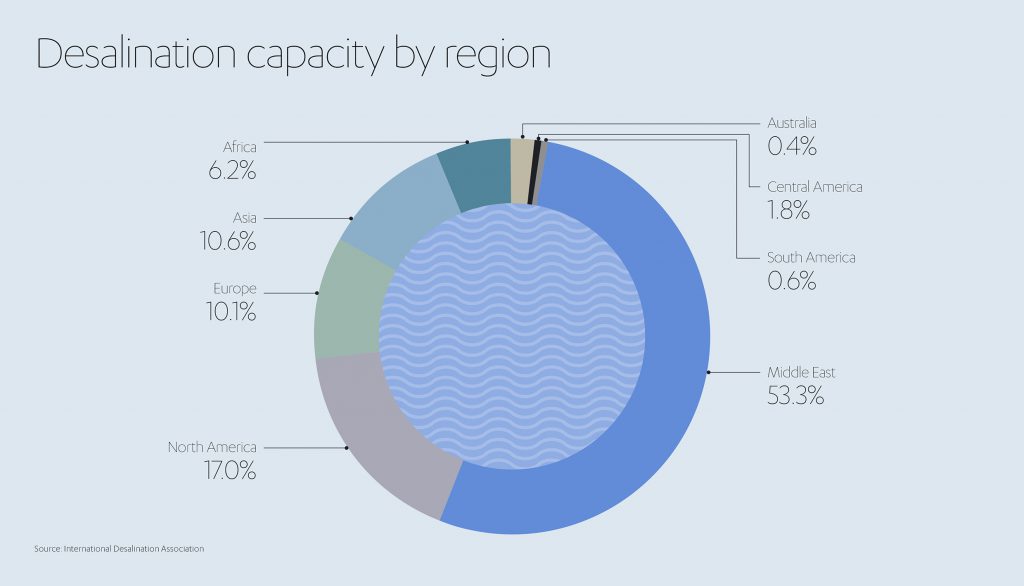
But desalination comes with its own challenges. There are two main types of desalination technologies: thermal, which heats up water and then captures the condensation, and reverse osmosis (RO), which forces sea water through a membrane. Both are very expensive to build, and both require a great deal of energy to operate. A typical reverse osmosis plant takes an average of 10 to 13 kilowatt hours of energy per every thousand gallons processed[16] and the greenhouse gas emissions created by the mostly fossil-fueled plants are a significant contributor to global warming. For example, the World Bank estimates that the approximately 30 desalination plants in Saudi Arabia rely on around 300,000 barrels of crude oil each day[17].
There are also ecological impacts. The backend of the desalination process produces a concentrated saltwater substance known as brine. This is disposed of by returning it to the ocean and, if not done properly by diffusing it over large areas, can deplete the ocean of oxygen and have negative impacts on sea life. It can also contain harmful copper and chlorine chemical compounds which end up in the seawater[18]. In fact, a 2019 study by the UN Institute for Water, Environment and Health[19] found that the problem of brine waste has been underestimated by 50%.
Another problem comes from the sucking in of sea water for processing. When a fish or other large organism gets stuck on the intake screen, it dies or is injured. In addition, fish larvae, eggs and plankton get sucked into the system and do not survive.
There also geographical considerations that mean some locations are simply not feasible for desalination plants. Water is heavy and very expensive to lift or transport, which means a desalination plant needs to be near its raw material, i.e. the sea; it needs to be close to its market or point of use; and geographically it should not be too far below its market because pumping up elevation is very expensive. Hence, the typical location of a desalination plant is along a coastal city or coastal industrial zone, supplying a relatively well-off industrial, commercial, or domestic demand.
New desalination technologies are being developed that aim to address some of these issues, such as solar powered desalination. Examples include a solar-powered desalination system in China that can provide more than 1.5 gallons of fresh drinking water per hour from one square meter of solar panel area[20], and the non-profit GivePower, which is supplying battery-driven solar-powered desalination systems to poor communities in Kenya and Haiti[21].
Steps are also being taken to reduce the generation of brine through Zero Liquid Discharge (ZLD) systems through which all wastewater is purified and recycled – hence leaving ‘zero’ discharge at the end of the process[22].
Nevertheless, there is no quick route to cheap, green and clean desalination as the answer to mankind’s water needs. More sustainable alternatives are urgently needed – and wastewater could be a key part of the solution.
In the words of the European Commission’s Environment Directorate:
“When compared to alternative sources of water supply such as desalination or water transfer, water reuse often turns out to require lower investment costs and energy, and also contributes to reducing greenhouse gas emissions.”[23]
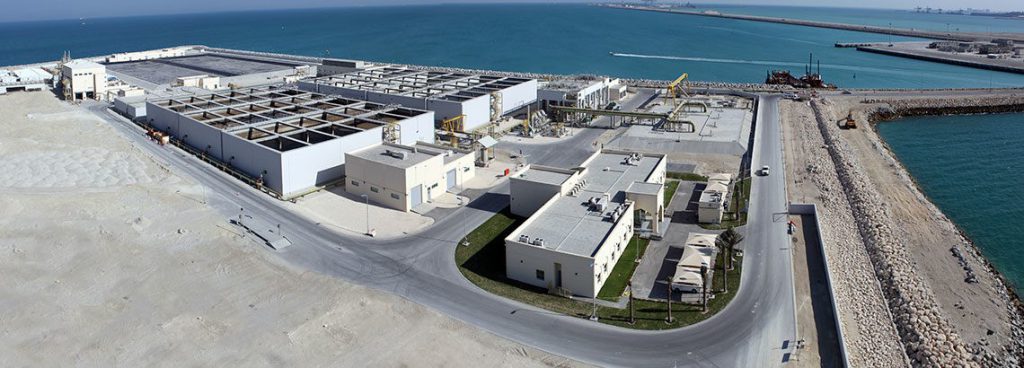
Waste not; want not
Cue the increasing level of investment and innovation around wastewater treatment systems.
Efficiently investing in wastewater treatment and other sanitation infrastructure is crucial to achieve public health benefits, improve the environment, and enhance quality of life. In addition, safely managed water, sanitation and hygiene services are an essential part of preventing disease and protecting human health during infectious disease outbreaks, including the current pandemic.
Treated wastewater is generally defined as water used by a business, home or industry that has been treated to remove its contaminants and is suitable for discharge. Treated processes can yield different qualities of final product to satisfy demand from a number of sectors, including industry and agriculture. It can be processed in ways that support the environment and can be reused as drinking water. In addition, by-products of wastewater treatment can be used in agriculture and energy generation, making wastewater treatment plants more environmentally and financially sustainable.
However, around 80% of the world’s wastewater is released into the environment without adequate treatment[24] – a valuable resource literally disappearing down the plughole before our eyes.
There is growing recognition of this missed opportunity and increasing acceptance that wastewater treatment can provide a cost-effective, flexible and sustainable solution to water scarcity, complementing the development of the desalination sector.
“At a time when 36% of the world’s population lives in water-scarce regions, wastewater treatment for reuse is part of the solution to water scarcity and pollution problems,” says Jennifer Sara, Global Director, World Bank Water Global Practice. “Once treated, it can be used to replace freshwater for irrigation, industrial processes, or recreational purposes. It can also be used to maintain the environmental flow and by-products from its treatment can generate energy and nutrients.”
Traditionally, investment in wastewater systems was hindered by four key barriers:
- Lack of public awareness and understanding, leading to negative perceptions towards reusing wastewater
- Technological, financial and regulatory barriers at local or regional levels that hinder investment in wastewater solutions. For example, local water specifications that do not recognize the use of recycled water
- Lack of economic incentives for either developers or users of wastewater solutions
- Lack of government action to require greater use of recycled water
In recent years, however, these barriers have been gradually diminishing, reflecting both a change in approach on behalf of authorities and growing global concerns over climate change and sustainability in general.

“The UN Sustainable Development Goals have also helped in this regard. They have focused attention on the climate crisis and people have recognized that we need to take action now, before it is too late,” says Carlos Cosín, CEO of Almar Water Solutions, part of Abdul Latif Jameel Energy & Environmental Services.
The global market for wastewater recycling and reuse was around US$ 12.2 billion in 2016 and is estimated to reach US$ 22.3 billion by 2021, according to the International Water Association[25]. Global contracted reuse capacity has almost doubled since 2010, with accumulated contracted capacity increasing from 59.7 million cubic meters per day (m3/d) in 2009 to 118 million in 2017[26], with China accounting for 49% of capacity contracted between 2010 and 2017.
There are some notable countries and cities demonstrating the potential of wastewater to transform water supplies:
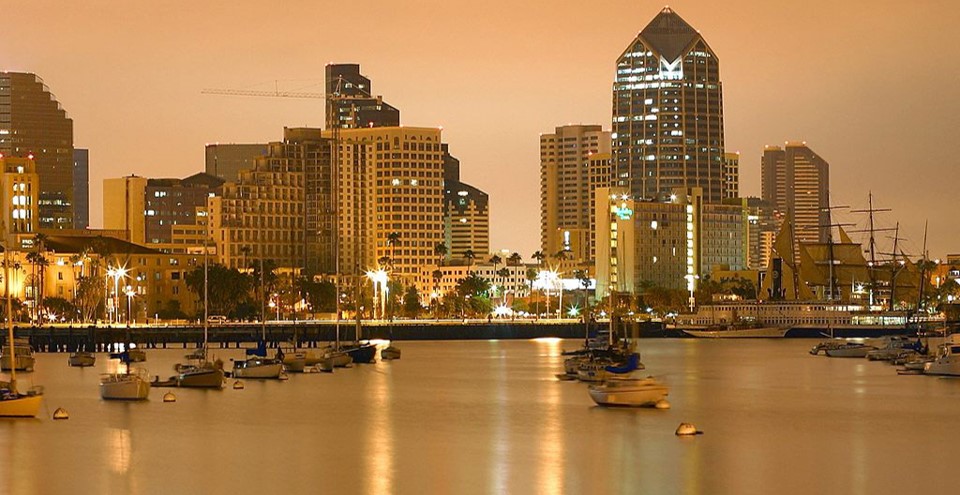
California dreamin’
California’s Title 22 Regulation lists 40 specific uses allowed with disinfected tertiary recycled water (such as irrigating parks), 24 specific uses allowed with disinfected secondary recycled water (such as irrigating animal feed and other unprocessed crops), and seven specific uses allowed with non-disinfected secondary recycled water (such industrial uses).
Other allowed uses of disinfected recycled water include irrigation of food crops and residential landscaping, air conditioning, commercial laundry, decorative fountains, and flushing toilets in commercial buildings.
Although it doesn’t allow for recycled drinking water use, it does allow for recycled water to be injected back into the water system and processed as normal into domestic water supplies.
At a local level, San Diego’s Water Purification Demonstration Project in 2012 showed how wastewater could be turned into a “reliable, sustainable and diversified” local purified water supply, suitable for drinking, with public approval for water reuse increasing from 26% in 2004 to 73% in 2012. The project, now known as Pure Water San Diego, was a 2015 winner of the US Water Alliance’s US Water Prize, and targets supplying the city with 83 million gallons of drinking water locally by 2035[27].
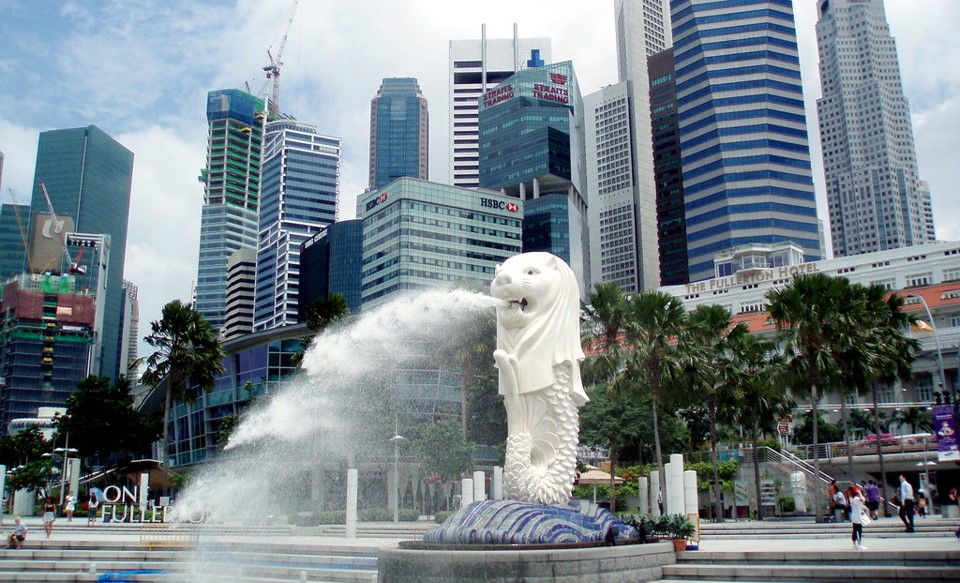
The Merlion City
Singapore is another beacon of wastewater success. Its NEWater initiative uses a process of microfiltration, reverse osmosis, ultraviolet disinfection and alkaline ‘pH’ balancing, to supply 40% of the city-state’s current water needs for both ultraclean and potable purposes from five water treatment plants. It aims to increase this to 55% by 2060[28].
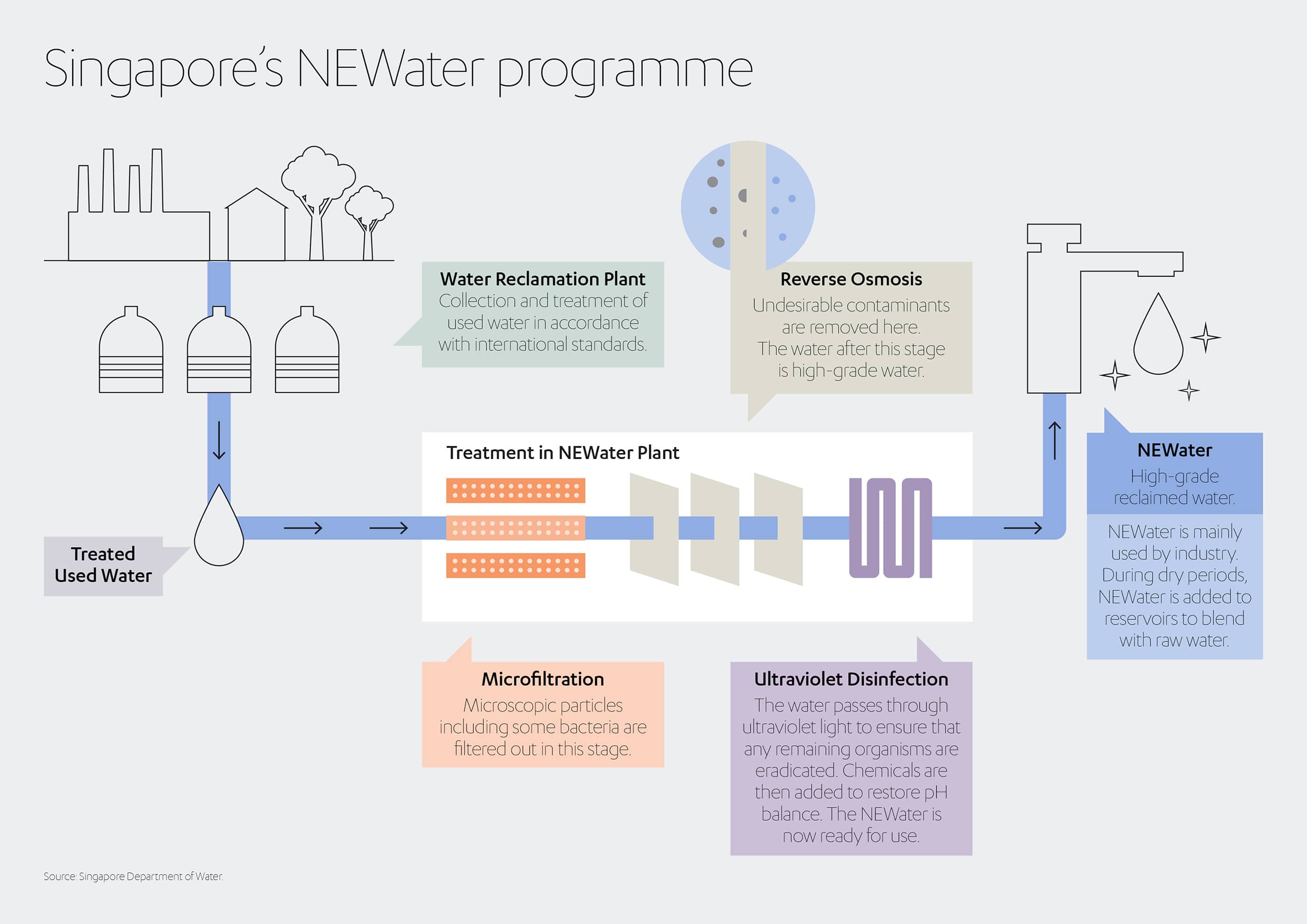
Similarly, the city of Aqaba in Jordan, one of the world’s most water-scarce countries, collects and treats 90% of its wastewater – around 31,000 million m3/d. The city’s resource recovery strategy has helped reduce its carbon emissions, green its urban landscapes, support both tourism and public health, and generate more than US$ 4 million for the Aqaba Water Company (AWC)[29]. Meanwhile, new legislation in the Philippines capital, Manilla, commits all stakeholders to manage and reuse 100% of their wastewater by 2028.[30]
“Places like California and Singapore have demonstrated that when you have the political will, it can be done,” says Cosín.
Almar Water Solutions is also transferring its leadership in desalination technology into sustainable wastewater treatment solutions. This includes a major stake in a 100,000 m3/d state-of-the-art wastewater treatment plant and sewer conveyance system at Muharraq in Bahrain. It follows the award of a contract to develop a 450,000 m3/d desalination plant in the Saudi Arabian coastal city of Al Shuqaiq. Covering the equivalent of 34 soccer fields, the Shuqaiq facility will guarantee reliable drinking water to 1.8 million people over 25 years and create 700 jobs[31],.
Similarly, in Egypt, where 7.3 million people have no access to safe drinking water and 8.4 million are deprived of proper sanitation, Almar Water Solutions is partnering with HA Utilities to develop wastewater management projects across the country.
Europe shows the way
Until recently, the situation in Europe was fragmented, reflecting disparate national legislation and agendas. The urgency of water scarcity is less of a priority for northern Europe, for example, than for southern, hotter countries like Spain, Italy or Greece. Spain has long been a strong proponent of wastewater treatment. It has led the European wastewater reuse market since introducing a national water reuse strategy in 2010, with large projects aimed at agricultural users.
“Spain uses around 10% to 12% recycled water, and it is increasing. In some regions like Murcia and the Canary Islands, the figure is as high as 25% and rising,” says Cosín.
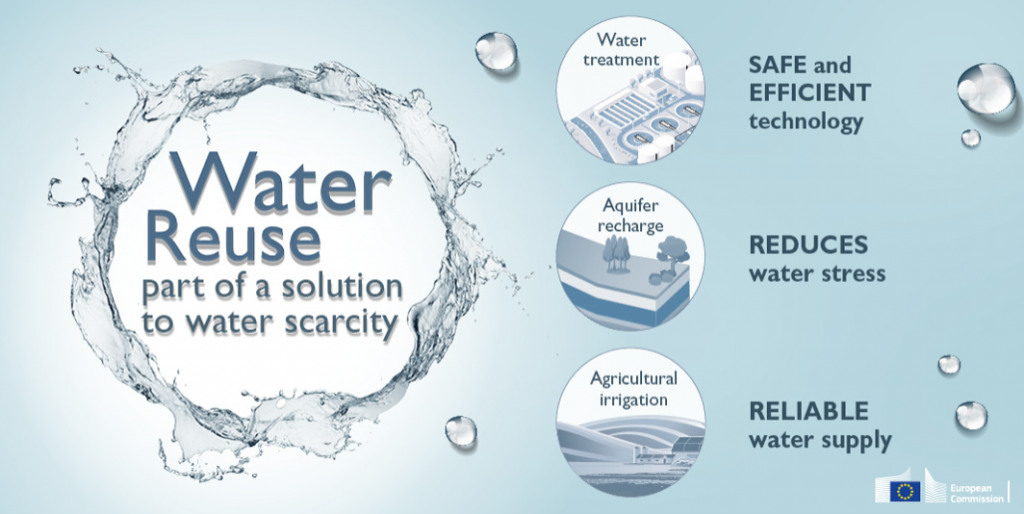
In 2020, the EU made a big step forward towards a consistent, coherent pan-EU water reuse framework when the European Parliament approved the Water Reuse Regulation. The new law defines minimum requirements at European level for the first time for reclaimed water (i.e. urban wastewater that has been treated in a reclamation plant) to be used for agricultural purposes in a safe way, protecting people and the environment.
This will be the first time the EU has defined such legislation and has the potential to increase its water reuse to 6.6 billion cubic meters per year, from the current 1.1 billion. The new regulation is also aimed at reducing the over exploitation of aquifers, considered one of the biggest threats to Europe’s water resources[32].
“Water is a precious resource. It makes sense to set harmonized minimum standards for reclaimed water quality and for compliance monitoring so that our farmers can use reclaimed water. Part of this is about learning from the experience of some member states which have been successfully reusing water for decades,” said Ioan Deneș, EU Minister of Waters and Forests.
Calmer seas ahead?
The new EU regulation is a major step forward and could potentially catapult Europe into the front ranks of the water reuse sector, spurring a new wave of investment and innovation. Nevertheless, many challenges remain if this vital technology is to truly deliver on its potential on a global scale.
“A global framework is needed. Currently, each region and country are working towards its own regulation, rather than adopting a more unified approach. While we have seen directives to change this in Europe, for example, this will be the biggest challenge over the next 10 years,” says Carlos Cosín.
To achieve this, supranational NGOs, government authorities, water companies, researchers and communities will all need to work together to unlock the advances necessary to secure the safe, clean, sustainable water supplies that our society relies on.
As Fady Jameel, Deputy President and Vice Chairman Abdul Latif Jameel – a long-time advocate of addressing the global water crisis comments:
“Only by prioritizing the water challenge and encouraging investment, innovation and partnerships across society, we can build an innovative wastewater treatment industry with the capacity to play a critical role in water security and global development.”
The good news is that unlike minerals or fossil fuels, water is almost infinitely renewable. As well as being our most abundant resource, it is also one of the most vital assets that we need to protect.
[1] http://www.fao.org/zhc/detail-events/en/c/880881/
[2] http://www.mckinsey.com/business-functions/sustainability/our-insights/water-a-human-and-business-priority?cid=eml-web
[3] https://www.economist.com/special-report/2018/08/14/priceless
[4] http://www.fao.org/zhc/detail-events/en/c/880881/
[5] http://www.mckinsey.com/business-functions/sustainability/our-insights/water-a-human-and-business-priority?cid=eml-web
[6] https://www.unwater.org/publications/world-water-development-report-2020/
[7] https://www.unenvironment.org/news-and-stories/press-release/half-world-face-severe-water-stress-2030-unless-water-use-decoupled
[8] https://www.worldbank.org/en/topic/water/publication/high-and-dry-climate-change-water-and-the-economy
[9] https://www.weforum.org/press/2020/01/burning-planet-climate-fires-and-political-flame-wars-rage
[10] http://www.fao.org/zhc/detail-events/en/c/880881/
[11] https://www.economist.com/special-report/2018/08/14/priceless
[12] https://www.unwater.org/publications/world-water-development-report-2020/
[13] https://www.unwater.org/publications/world-water-development-report-2020/
[14] https://www.nationalgeographic.com/environment/2019/01/desalination-plants-produce-twice-as-much-waste-brine-as-thought/
[15] https://www.sciencedirect.com/science/article/pii/S0048969718349167
[16] https://www.nationalgeographic.com/environment/2019/01/desalination-plants-produce-twice-as-much-waste-brine-as-thought/
[17] http://documents.worldbank.org/curated/en/476041552622967264/pdf/135312-WP-PUBLIC-14-3-2019-12-3-35-W.pdf
[18] https://www.nationalgeographic.com/environment/2019/01/desalination-plants-produce-twice-as-much-waste-brine-as-thought/
[19] https://www.sciencedirect.com/science/article/pii/S0048969718349167
[20] http://news.mit.edu/2020/passive-solar-powered-water-desalination-0207
[21] https://www.pv-magazine.com/2020/02/06/a-new-solar-desalination-system-to-address-water-scarcity/
[22] https://www.aquatech.com/solutions/zero-liquid-discharge/
[23] https://ec.europa.eu/environment/water/reuse.htm
[24] https://www.worldbank.org/en/news/press-release/2020/03/19/wastewater-a-resource-that-can-pay-dividends-for-people-the-environment-and-economies-says-world-bank
[25] https://reliefweb.int/report/world/wastewater-report-2018-reuse-opportunity
[26] https://www.aquatechtrade.com/news/water-reuse/spain-and-china-continue-as-water-reuse-heavyweights/
[27] https://www.sandiego.gov/public-utilities/sustainability/pure-water-sd
[28] https://www.pub.gov.sg/watersupply/fournationaltaps/newater
[29] https://reliefweb.int/sites/reliefweb.int/files/resources/OFID%20Wastewater%20report%202018%20screen.pdf
[30] https://reliefweb.int/sites/reliefweb.int/files/resources/OFID%20Wastewater%20report%202018%20screen.pdf
[31] https://www.almarwater.com/2019/05/09/almar-water-solutions-to-acquire-mubadala-infrastructure-partners-investment-in-muharraq-sewage-treatment-plant-in-bahrain/
[32] https://www.consilium.europa.eu/en/press/press-releases/2020/04/07/water-reuse-for-agricultural-irrigation-council-adopts-new-rules/





 1x
1x

 Added to press kit
Added to press kit


